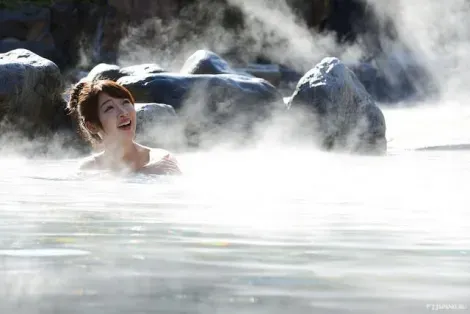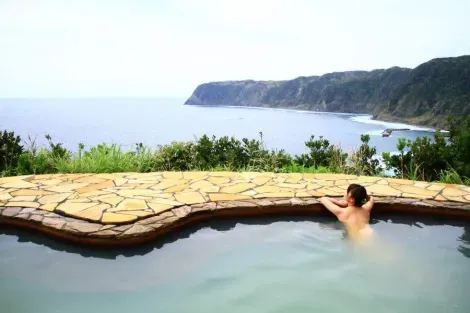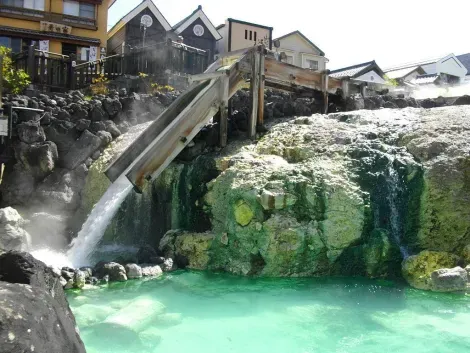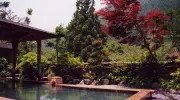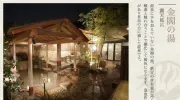Onsen, Hot Springs and Public Baths
Dive into Japanese baths!
Sources of relaxation synonymous with wellness spas (onsen) and public baths (sento) delight Japanese. An essential experience for any visitor to Japan, Japan's public baths and onsen are fantastic and unique ways to relax.
Public baths in Japan: relaxation and sharing
A favorite destination for tourists in Japan is the stress killing onsen, 100% pure happiness. Bathing puts everyone in a good mood in Japan. Families, couples or friends, women on one side and men on the other (separated since the arrival of the American army), they engage in this relaxing immersion totally nude. To not experience this in Japan is to seriously miss out.
- Find out more: Onsen etiquette
You should know that the bath in Japan is not used for washing. To enter the clear warm waters, one must be clean as a whistle. For the waters of the kami (Shinto gods) can not be soiled.
Lost in the mountains, coiled on the coast facing Mount Fuji, in the big city or in the countryside, the springs are located throughout the country. There are more than 27,000. In 2015, the Japan Ministry of Environment officially identified 3,184 spas, visited by 132 million people each year.
- Read more: Public baths in Tokyo
Full of healthy minerals
A volcanic island, Japan, brings together the geological conditions conducive to the development of thermal springs. Because the onsen water comes from volcanic sources, they are naturally heated and have, according to their mineral or chemical composition, therapeutic properties which establishments pride themselves on. Rich in sulfur, sodium, carbonic acid or iron, Japanese thermal springs are renowned for helping to cure many diseases. Even animals appreciate them: you just have to see the Jigokudani macaques basking in the park's hot springs to be convinced!
To have the complete the well-being experience, you must try a rotenburo, or an outdoor thermal spring, an essential in Japan. Here is a selection of five that have the best views, a view of the sea, the forest or Mount Fuji.
- Read more: Five amazing facts about onsen
At the sources of Japanese civilization
The history of onsen is preceded by many myths and legends, where the thermal springs had their own kami, the deities of Japan. It is assumed that the first inhabitants of Japan settled around thermal springs, as the salt content of which attracted game. Onsen became be a source of Japanese civilization. According to the Nihon shoki (Chronicles of Japan, written in 720), the first thermal spring would have been created in 631 in the prefecture of Hyogo: the Arima Onsen. The thermal spring of Dogo Onsen, in Matsuyama, is also among the oldest. She even inspired the film Spirited Away, by Hayao Miyazaki.
From the Kamakura era (1185-1333), onsen, until then places of worship of kami, began to be used for therapeutic purposes. Buddhist monks, such as Ippen (1239-1289), use them for their religious practice, helping them generalize the use of thermal springs among the Japanese. During the Sengoku era of the warring provinces (1450-1573), the lords also appreciated their relaxing benefits between battles.
From thermalism to tourism
At the time of Edo period (1603-1868), spa establishments were created around onsen, welcoming and accommodating Japanese people wishing to receive cures for different ailments. These onsens were quick to welcome tourists for short stays of one or two nights, as is still the case today. Onsen then becomes a cultural practice rooted in Japanese life and today makes visitors from overseas very happy.
For further reading:
Onsen, sources thermales et bains publics
Other themes :
- Train in Japan
- Attractions and Excursions
- Before you Travel
- Books on Japan
- Events and Festivals
- Family Travel
- Getting Around Kyoto
- Getting Around Tokyo
- Itineraries for Japan
- Japanese Food and Drink
- Japanese History
- Japanese Language
- Japanese Movies
- Japanese Pop Culture
- Japanese Stations
- Markets in Japan
- Museums and Galleries
- Nightlife in Japan: Going out, seeing and drinking
- Outdoor Activities
- Parks and Gardens
- Restaurants and Cafes
- Shinkansen Travel Tips
- Shopping and souvenirs
- Temples and shrines in Japan
- Travelling in Japan: a comprehensive guide
- Understanding Japan
- Unique Trains in Japan





